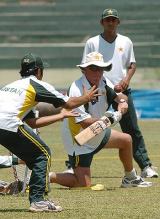Coaching the uncoached
Bob Woolmer on the differences in coaching in the subcontinent
Bob Woolmer
08-Nov-2006
|
|

|
People often ask me about the differences between coaching Pakistan and coaching South Africa or Warwickshire. Naturally there is a broad difference in cultures, the East-West divide. But in others way also the experience is different.
The language and understanding of English-based terminology has led to some humorous exchanges in Pakistan. A good example was Yasir Hameed, who after a day in the field was asked to go onto the field and have a stretch to warm down after the day's play. He turned to our trainer Murray Stevenson and I and said "Do you mind if I go and stretch in flat feet?" Obviously we were surprised, until he explained he actually wanted to go without shoes on. Bearing this in mind there is a clear danger that when you explain anything, it is imperative to check that what you have said is understood and that the real meaning has been absorbed.
The language barrier is not a new experience for me; I often site the example of when I coached a group of six and seven-year olds, all beginners, and asked them to step backwards and forwards as one does when playing back and forward in cricket. But it was patently obvious when they actually stepped forward and backwards, as one would do when setting off to walk, that better terminology was needed. As a batsman stands sideways to the bowler, going forward to meet the ball is actually a step to the left (for right handers and vice versa for left handers).
This is why I stress during coaching courses and conferences that we must strive to explain precisely what you mean and not just accept that players will understand. This example is of course an extreme one.
Other challenges are deeper-set. On one occasion, when talking to our opening batsmen in Perth after the game, I discovered that they were misreading of the swing of the Australian bowlers. Conventional swing means that the ball swings away from the shiny side while reverse swing means the ball swings towards the shiny side. But the preponderance of reverse swing as a skill in Pakistan meant that our openers were misreading the swing.
Similarly we readily say that the ball moves according to the seam which acts as a rudder. However, if you have been brought up miles away from a boat or plane manufacturer you will quickly discover that not many kids know what a rudder is. This lack of understanding terminologies is not uncommon in the western world, let alone to those cricketers hailing from poor economic backgrounds in Asia.
In batting especially, understanding how trigger movements work is interesting. There are various terminologies that batsmen from countries such as England, Australia and New Zealand will share with each other, such as the 'back and across' movement or the forward press, more favoured for trips to the subcontinent.
However, the back and across movement in Asia is commonly associated with a shuffle, which suggests just that. In reality, of course, any trigger movement is based around not on what you do but when. If you move in delivery your eyes move across the line and also up and down and consequently, judgment of line and length will be impaired which results in poor shot selection.
It has also been interesting to see how Pakistani batsmen adjust to batting on a different surface and against the moving ball. The average county cricketer of my era would have set game plans for all sorts of pitches from the wet sticky dog (incidentally, one of my players thought a sticky dog was a pudding) to the green seamer to the dusty turner. But pitches now are usually pretty flat and when confronted with movement, most batsmen today cry foul. The pitches are usually covered and the amount of grass is monitored (except in Mohali). Different balls too will affect the game because the seam is too proud or the ball is too hard: the difference between the Kookaburra and the Duke is marked.
Off the field, there is still much room for superstition in this part of the world and many players insist on repeating processes and traits to keep their luck. At the highest level, it is important to remain realistic and honest but in Asia the fear of the supernatural and of people trying unseat you through dastardly means looms large. This is not exclusive to Asia: I was speaking to Bennett King, the West Indies coach, and he too has had to try and explain that many of these myths (for example, if you get into a cold swimming pool you will catch a cold) are old wives tails. My own mother used to tell me never to cut my nails on a Sunday or not to buy a green car or walk under a ladder.
Ultimately, coaching Pakistan has been fascinating because it has posed questions. How should I correct or adapt common cricketing terminology to help the cricketers of Pakistan? Also, are we necessarily right in assuming that the structured way players are coached in England or Australia is the best?